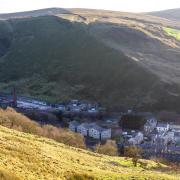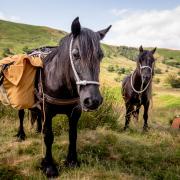Bob Pettifer is a man with his head in the clouds. With 18,000 air hours under his belt he is one of the most experienced fliers at Bowland Forest Gliding Club and has effectively spent two years of his life in the sky.
At 73, he has been flying gliders for nearly 60 years starting in the Air Cadets before becoming a navigator in the RAF and then an instructor. Even now, he still gets the same thrill when he is in the air.
‘You look to the sky and you wish you were up there. And when you are up there it’s a challenge for you personally. Powered flying is more precise but gliding is part art and part science,’ he said.
Bob has been a member of the club since 1972, a year before the members bought a 56-acre farm on the outskirts of Chipping which has been their headquarters ever since. As club instructor for 12 years and now chairman, he has taught more than 100 people to fly and for many years was chair of the British Gliding Association Instructors’ Committee. ‘I like flying duo, to share the experience,’ he said. But as he points out, not all training is done in the air and members have to attend lectures, learn about emergency procedures, clouds and thermals, how the glider operates, navigation and radio work.
Bob has seen lots of changes over the years but says you can have as much fun in an old wooden glider, costng a few thousand, as you can in the fibreglass models which sell for hundreds of thousands. Many use the club’s aircraft and others buy a share in a glider which costs from £800. Everyone stresses it’s a sport which is neither expensive nor elitist.
Although Bob has concentrated on training, many others like to do long distances in their unpowered craft with regular trips reaching more than 750km.
Of the 82 active members only eight are women. Laura Maksymowicz, a software engineer at BAE Systems in Warton, is one of the youngest at 27. Her father took her gliding when she was 16, she went solo the following year and continued to learn at university where she was President of the Gliding Club. ‘I started when I was at school, it’s just something different. I could fly before I could drive a car. It’s not just about the flying though, it’s the people,’ she said. Generally the club tends to attracts men in their 50s although many are much older. The club rules that once you reach the age of 80 you are not allowed to fly solo. ‘Much to their annoyance,’ said honorary secretary Tony Perry. ‘A lot of people like me start to learn in their 50s when they have more time. I always had a desire to fly but I did not think I could as I am a diabetic. My wife booked me a trial lesson to get it out of my system but it all backfired!’
He has been a member of the club for nearly seven years and can now fly solo. ‘It’s such a tremendous feeling, it’s very involving and in such a beautiful area, soaring over the Bowland Fells and up the Ribble Valley in almost total silence.’
Each time one of the club’s gliders is launched a ground crew of five to seven people are needed to pull it into position, hold the wing, attach the cable and operate the radio. ‘If you are not flying you are helping other people,’ said Tony. ‘You might fly for half an hour and spend rest of the time helping other people fly.’ The club has four single seaters and three double seaters and there are an additional 32 privately-owned gliders, many purchased by small syndicates.
Many of the instructors are in their 70s and the club prides itself on its wealth of experience and that all instruction for new members is free. ‘Most people have been members for decades, we get about seven or eight new members a year. But we are trying to encourage youth members as we are a Junior Gliding Centre,’ said Tony.
Youngsters can join at 13 and fly solo at 14. Sam McCormack, of Todmorden, is following in his older brother’s footsteps who learnt to fly at the club and is now an instructor for the ATC. Sam, 15, said: ‘It feels like the right sort of element to be in, no longer fastened to the ground. It is a very poetic and natural way of flying.’
The club was founded in 1950 at Blackpool Airport but moved to Chipping 40 years ago. In that time the volunteers – no-one is paid - have transformed the farm by creating a runway, turning the shippon into a clubhouse with offices, lecture room, bedrooms, bar and eating area. There’s also a hangar and workshop and the main farmhouse is rented to tenants.
On clear sunny days locals know they’ll see the gliders over the Bowland hills of Fair Snape Fell and Parlick, yet the club is still very much part of the rural community. Most nights when flying has finished, a local farmer grazes his sheep on their land.
Flight fantastic
So what’s the appeal of sitting in a tiny plane and effectively being pitched 1,100 feet into the air via a winch and then having to rely on thermals and other patches of rising air without the backup of an engine if anything goes wrong? Sheer fun is the answer. It’s real back to basics flying; one person using their wits to work with the elements around them.
On my trial flight club chairman Bob Pettifer was my instructor and after being equipped with a parachute we got into the narrow glider, me in front, him behind. It’s a friendly club with lots of people wanting you to enjoy their sport as much as they do. The launch was exhilarating, within seconds we were soaring at 1,100ft and looking for thermals to take us higher. We reached 1,800 feet as Bob pointed out lenticular clouds which are the ones to head for if you want to rise really quickly. Perhaps not as silent as I was expecting – the gliders are equipped with radios and other equipment which beep as you soar and dip – but seeing the countryside from an aerial perspective and still at close quarters was superb. I was there on a perfect flying day but all the members said the sport is so weather dependent it can sometimes lead to disappointment. However they all agreed that just one good flight every now and then lives in the memory.
No high prices
After joining the club and paying the membership fee, it costs £5 per launch and 25p for every minute you are up in the air. But members say its still the cheapest form of flying – for example, an hour in a powered plane costs in the region of £150 - and trial lessons are available for just £50. For more information about the club go to www.bfgc.co.uk



























